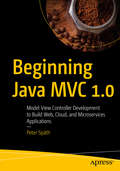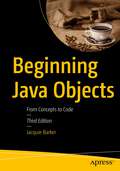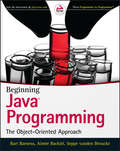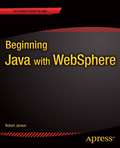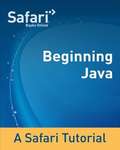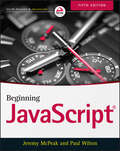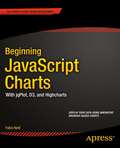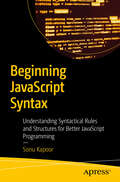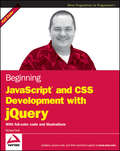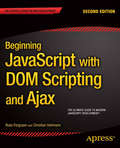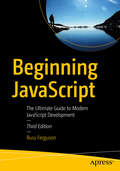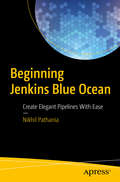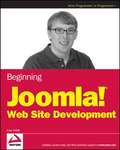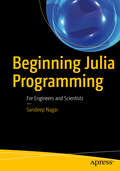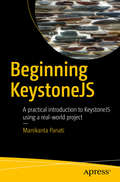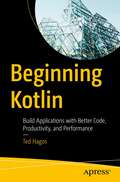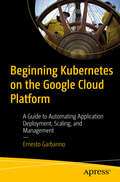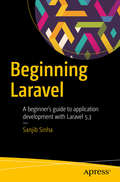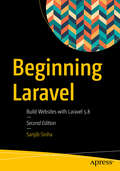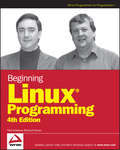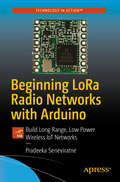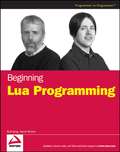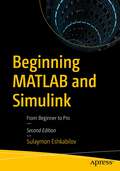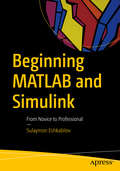- Table View
- List View
Beginning Java MVC 1.0: Model View Controller Development to Build Web, Cloud, and Microservices Applications
by Peter SpäthGet started with using the new Java MVC 1.0 framework for model, view, and controller development for building modern Java-based web, native, and microservices applications. Beginning Java MVC teaches you the basics, then dives in to models, views, controllers. Next, you learn data binding, events, application types, view engines, and more. You will be given practical examples along the way to reinforce what you have learned. Furthermore, you'll work with annotations, internationalization, security, and deployment. After reading this book, you'll have the know how to build your first full Java-based MVC application. What You Will Learn Discover the Java MVC 1.0 APIs and how to use them Master the Model, View and Controller design pattern Carry out data binding Write events Work with view engines Who This Book Is For Those new to Java MVC 1.0. Some prior experience with Java programming recommended, especially with JSF or Struts.
Beginning Java Objects: From Concepts to Code
by Jacquie BarkerExport author Barker covers information key for proficiency with an OO programming language like Java, and shows how to really create reusable code and extensible applications.
Beginning Java Programming: The Object Oriented Approach
by Bart Baesens Seppe Vanden Broucke Aimee BackielA comprehensive Java guide, with samples, exercises, case studies, and step-by-step instruction Beginning Java Programming: The Object Oriented Approach is a straightforward resource for getting started with one of the world's most enduringly popular programming languages. Based on classes taught by the authors, the book starts with the basics and gradually builds into more advanced concepts. The approach utilizes an integrated development environment that allows readers to immediately apply what they learn, and includes step-by-step instruction with plenty of sample programs. Each chapter contains exercises based on real-world business and educational scenarios, and the final chapter uses case studies to combine several concepts and put readers' new skills to the test. Beginning Java Programming: The Object Oriented Approach provides both the information and the tools beginners need to develop Java skills, from the general concepts of object-oriented programming. Learn to: Understand the Java language and object-oriented concept implementation Use Java to access and manipulate external data Make applications accessible to users with GUIs Streamline workflow with object-oriented patterns The book is geared for those who want to use Java in an applied environment while learning at the same time. Useful as either a course text or a stand-alone self-study program, Beginning Java Programming is a thorough, comprehensive guide.
Beginning Java with WebSphere
by Robert W JansonBeginning Java with WebSphere provides a step-by-step guide for creating and installing both client- and server-based Java applications using Rapid Application Development v8, WebSphere Application Server 8. 0, and Java. Since more and more Java applications are moving to the server and using HTML for the user interface, there is a minimal amount of time spent exploring the Java GUI components. More specifically, this book covers graphical user interfaces using RAD's Visual Editor, variables, conditional logic, and application improvements/enhancements from the client side. And, from the server-side, this book covers servlets, JavaServer Pages (JSPs), database accessibility (JDBC), custom tags, and concludes with JavaServer Faces (JSFs). This book concentrate on base topics that allow you to get to the server-side and database topics quickly.
Beginning Java: A Safari Tutorial
by Safari Content TeamThis is the first of a 3 part series of tutorials to learn Java Skills in Safari Books Online. This beginning Java tutorial is designed for individuals that may not have development experience, or developers who have had non-Java development experience, such as Cobol programming. Developing applications with Java uses an object-oriented programming (OOP) approach, and relies heavily upon the OOP paradigm to describe and use the functionality of the language. Key concepts such as inheritance, objects, classes and the heavy typing used to declare variables and their contents are not optional, but they are instead required elements of the language. Follow along in this tutorial to learn about all of these beginning Java skills in Safari Books Online.
Beginning JavaScript
by Paul Wilton Jeremy McpeakThe perennial bestseller returns with new details for using the latest tools and techniques available with JavaScriptJavaScript is the definitive language for making the Web a dynamic, rich, interactive medium. This guide to JavaScript builds on the success of previous editions and introduces you to many new advances in JavaScript development. The reorganization of the chapters helps streamline your learning process while new examples provide you with updated JavaScript programming techniques.You'll get all-new coverage of Ajax for remote scripting, JavaScript frameworks, JavaScript and XML, and the latest features in modern Web browsers. Plus, all the featured code has been updated to ensure compliance with the most recent popular Web browsers.Introduces you to the latest capabilities of JavaScript, the definitive language for developing dynamic, rich, interactive Web sitesFeatures new coverage of data types and variables, JavaScript and XML, Ajax for remote scripting, and popular JavaScript frameworksOffers updated code that ensures compliance with the most popular Web browsersIncludes improved examples on the most up-to-date JavaScript programming techniquesContinuing in the superlative tradition of the first three editions, Beginning JavaScript, Fourth Edition, gets you up to speed on all the new advances in JavaScript development.Note: CD-ROM/DVD and other supplementary materials are not included as part of eBook file.
Beginning JavaScript
by Jeremy McpeakThe bestselling JavaScript guide, updated with current features and best practices Beginning JavaScript 5th Edition shows you how to work effectively with JavaScript frameworks, functions, and modern browsers, and teaches more effective coding practices using HTML5. This new edition has been extensively updated to reflect the way JavaScript is most commonly used today, introducing you to the latest tools and techniques available to JavaScript developers. Coverage includes modern coding practices using HTML5 markup, the JSON data format, DOM APIs, the jQuery framework, and more. Exercises with solutions provide plenty of opportunity to practice, and the companion website offers downloadable code for all examples given in the book. Learn JavaScript using the most up to date coding style Understand JSON, functions, events, and feature detection Utilize the new HTML5 elements and the related API Explore new features including geolocation, local storage, and more JavaScript has shaped the Web from a passive medium into one that is rich, dynamic, and interactive. No matter the technology on the server side, it's JavaScript that makes it come alive in the browser. To learn JavaScript the way it's used today, Beginning JavaScript, 5th Edition is your concise guide.
Beginning JavaScript Charts: With jqPlot, d3, and Highcharts
by Fabio NelliBeginning JavaScript Charts shows how to convert your data into eye-catching, innovative, animated, and highly interactive browser-based charts. This book is suitable for developers of all experience levels and needs: for those who love fast and effective solutions, you can use the jqPlot library to generate charts with amazing effects and animations using only a few lines of code; if you want more power and need to create data visualization beyond traditional charts, then D3 is the JavaScript library for you; finally, if you need a high-performance, professional solution for interactive charts, then the Highcharts library is also covered. If you are an experienced developer and want to take things further, then Beginning JavaScript Charts also shows you how to develop your own graphics library starting from scratch using jQuery. At the end of the book, you will have a good knowledge of all the elements needed to manage data from every possible source, from high-end scientific instruments to Arduino boards, from PHP SQL databases queries to simple HTML tables, and from Matlab calculations to reports in Excel. You will be able to provide cutting-edge charts exploiting the growing power of modern browsers. Create all kinds of charts using the latest technologies available on browsers (HTML5, CSS3, jQuery, jqPlot, D3, Highcharts, and SVG) Full of step-by-step examples, Beginning JavaScript Charts introduces you gradually to all aspects of chart development, from the data source to the choice of which solution to apply. This book provides a number of tools that can be the starting point for any project requiring graphical representations of data, whether using commercial libraries or your own What you'll learn Learn the jqPlot, D3, Highcharts, CSS, jQuery and SVG basics. Discover the world of JavaScript graphic libraries. Discover which charts can best represent your data. Switch from a vision of a chart sent from a server as a static image to a highly dynamic one, in which the user is able to interact in real time. Perform input data manipulation to increase chart readability. Develop your own graphic library. Who this book is for Beginning JavaScript Charts is for developers at all levels interested in data visualization, and ready to embrace modern web standards and animate and display their data with powerful, cutting-edge technologies. Table of Contents Charting Technology Overview jQuery Basics Simple HTML Tables Drawing a Line Chart Drawing a Bar Chart Drawing a Pie Chart Creating a Library for Simple Charts Introducing jqPlot Line Charts with jqPlot Bar Charts with jqPlot Pie Charts with jqPlot Candlestick Charts with jqPlot Bubble Charts with jqPlot Other Charts with jqPlot Adding Controls to Charts Embedding jqPlot Charts in jQuery Widgets Handling Input Data Moving from jqPlot to Highcharts Introducing D3 Line Charts with D3 Bar Charts with D3 Pie Charts with D3 Candlestick Charts with D3 Scatterplot and Bubble Charts with D3 Radar Charts with D3 Handling Live Data with D3 App A: Guidelines for the Examples in the Book App B: jqPlot Plugins
Beginning JavaScript Syntax: Understanding Syntactical Rules and Structures for Better JavaScript Programming
by Sonu KapoorThis book is a practical and beginner-friendly guide that focuses exclusively on the syntax of JavaScript, the most widely-used programming language for web development today. Designed to be a clear and accessible introduction for new learners, this book will teach you the essential syntax rules and constructs of JavaScript in a structured, easy-to-understand format. With the explosive growth of web applications and the continued dominance of JavaScript in frameworks like Angular, React, and Node.js, learning JavaScript has never been more relevant. For those starting out in web development, this book will provide the essential foundation needed to build more advanced skills. While other beginner guides may try to cover too much too quickly, this book deliberately focuses on core syntax, so you build a solid understanding from the ground up. Understanding syntax is the first step toward becoming a proficient programmer. JavaScript, in particular, is a flexible yet quirky language with its own unique syntax and conventions. For beginners, this can be overwhelming, but this book demystifies the language&’s structure and explains how to use JavaScript's syntax to write effective and efficient code. Mastery of syntax is critical for writing clean, readable code, and for avoiding common programming errors. The book covers a range of foundational topics, from understanding basic syntax elements like variables, operators, and data types, to mastering control flow with conditionals and loops, and working with more complex structures like functions, objects, and arrays. It also introduces the modern ES6+ syntax features that are now standard in most JavaScript projects, such as arrow functions, destructuring, and template literals. By the end of this book, you will not only have a strong grasp of JavaScript&’s syntax, but also the confidence to write, debug, and maintain your own JavaScript code effectively. Whether you&’re an aspiring developer or someone looking to solidify their understanding of JavaScript&’s building blocks, this book will serve as a valuable resource in your journey. You Will Learn: How to use JavaScript&’s core syntax elements, including variables, data types, operators, control flow (conditionals and loops), and functions. Techniques to debug common JavaScript errors and write clean, readable code How to use key ES6+ syntax features such as arrow functions, template literals, destructuring assignments, and the spread/rest operators How to manipulate the DOM, handle user interactions, and manage data This book is for: Web developers, students, or professionals transitioning into the tech industry
Beginning JavaScript and CSS Development with jQuery
by Richard YorkThis book covers the jQuery JavaScript framework and the jQuery UI JavaScript framework to get more results faster out of JavaScript programming. The author covers each method exposed by jQuerys API, which contains methods to resolve common, redundant tasks in less code. You will also learn how jQuery eliminates certain cross-browser, cross-platform development headaches like the event model. In addition to giving you the ability to simulate events, this book also helps simplify your work with events by reducing the amount of code that you need to write to attach events.
Beginning JavaScript with DOM Scripting and Ajax: Second Editon (Beginning: From Novice To Professional Ser.)
by Christian Heilmann Russ FergusonBeginning JavaScript with DOM Scripting and Ajax is an essential resource for modern JavaScript programming. This completely updated second edition covers everything you need to know to get up-to-speed with JavaScript development and add dynamic enhancements to web pages, right from the basics. As well as focusing on client-side JavaScript, you will also learn how to work with the Browser Object Model, the Document Object Model (DOM), how to use XML and JSON as well as communicate with service side scripts such as PHP. Find out how to: Construct good JavaScript syntax following modern coding practices Use JavaScript to communicate with the server and retrieve data Dynamically manipulate markup, validate forms and deal with images Debug applications using features inside the browser JavaScript is one of the most important technologies on the web. It provides the means to add dynamic functionality to your web pages and serves as the backbone of Ajax-style web development. Beginning JavaScript with DOM Scripting and Ajax will take you from being a JavaScript novice to work freely with this important technology - begin your JavaScript journey today!
Beginning JavaScript: The Ultimate Guide to Modern JavaScript Development
by Russ FergusonDiscover everything you need to know to get up-to-speed with JavaScript development and add dynamic enhancements to web pages. This completely updated third edition reveals how the code works and when to use closures, constants, and execution content. <p><p> Starting with the basics, you’ll see how to employ prototypical inheritance, as well as memory management, variable hoisting and event bubbling. Also covered is an introduction to Node.js and package managers, key to understanding the tools necessary in front-end development and how they are used with current JavaScript frameworks. <p><p> JavaScript is one of the most important technologies on the web, providing the means to add dynamic functionality to your web pages and serving as the backbone of working with frameworks like Angular and React. Beginning JavaScript, Third Edition will take you from being a JavaScript novice to working freely with this important technology - begin your JavaScript journey today! What You'll LearnConstruct good JavaScript syntax following modern coding practicesUse JavaScript to communicate with the server and retrieve dataDynamically manipulate markup, validate forms and deal with imagesDebug applications using features inside the browserUse TypeScript to bring strong typing to the languageWho This Book Is For Beginner to intermediate developers with a basic knowledge of front-end programming who are looking for a deeper understanding of how JavaScript works in the browser and how to answer questions in an interview. <P><P><i>Advisory: Bookshare has learned that this book offers only partial accessibility. We have kept it in the collection because it is useful for some of our members. Benetech is actively working on projects to improve accessibility issues such as these.</i>
Beginning Jenkins Blue Ocean: Create Elegant Pipelines With Ease
by Nikhil PathaniaDive deep into Jenkins Blue Ocean and discover how easy creating a pipeline can be. You’ll see how Blue Ocean provides a better user experience when designing, running, and visualizing pipelines. This book shows you its intuitive user interface and its powerful pipeline editor and how this makes it a tool for everyone.Beginning Jenkins Blue Ocean starts with an introduction to Blue Ocean, followed by a step-by-step guide on how to set it up. You’ll learn how to create a pipeline for every branch and pull request on your Git, GitHub, and GitLab repositories. You'll experience the improved pipeline visualization and log diagnosis features in Blue Ocean. Later you will go beyond the visual pipeline editor to learn the declarative syntax and gain better control over your pipelines. Then, you'll take a look at some tools to enable you to write pipeline code in the declarative syntax. You will also learn to extend delivery pipelines with Jenkins shared libraries.What You Will LearnDiscover Jenkins Blue Ocean and how to use itCreate elegant pipelines using the visual pipeline editorWork with the declarative pipeline syntax Use tools that help you write declarative pipeline code Extend pipelines with Jenkins shared librariesVisualize pipelines from classic Jenkins in Blue OceanConfigure and view test results in Blue OceanAccurately diagnose pipeline failures using improved pipeline visualizationCreate multibranch pipeline projects for your Git, GitHub, and GitLab repositoriesWho This Book Is ForThose new to Jenkins who are looking for an easy introduction. The book will also be useful for readers familiar with classic Jenkins and would like to learn Jenkins Blue Ocean.
Beginning Joomla! Web Site Development
by Cory WebbBy programmers for programmers-the essential beginner's guide to building websites with Joomla! Want to build and maintain dynamic websites without having to learn HTML and CSS? Joomla! open-source web content management system and this beginner's guide are all you need. This book walks you step-by-step through the process of building a website with Joomla!, providing detailed instruction in Wrox's practical, programmer-to- programmer style. The book explores key concepts and shows how each concept relates to the development of an actual real-world web site you can access online. Joomla! is an open-source web content management system used to build and maintain dynamic web sites without using specific web languages like HTML and Cascading Style Sheets (CSS) Walks you step by step through the process of building a website with Jooma! and features plenty of examples of actual websites that illustrate concepts Topics include configuration; managing content, core modules, plugins, menus, and extensions; building custom templates; and performing troubleshooting; also provides advanced tips and tricks, and more From configuration and management to troubleshooting and advanced tips, this is the book to get you up and running with Joomla!
Beginning Julia Programming: For Engineers and Scientists
by Sandeep NagarGet started with Julia for engineering and numerical computing, especially data science, machine learning, and scientific computing applications. This book explains how Julia provides the functionality, ease-of-use and intuitive syntax of R, Python, MATLAB, SAS, or Stata combined with the speed, capacity, and performance of C, C++, or Java. You'll learn the OOP principles required to get you started, then how to do basic mathematics with Julia. Other core functionality of Julia that you'll cover, includes working with complex numbers, rational and irrational numbers, rings, and fields. Beginning Julia Programming takes you beyond these basics to harness Julia's powerful features for mathematical functions in Julia, arrays for matrix operations, plotting, and more. Along the way, you also learn how to manage strings, write functions, work with control flows, and carry out I/O to implement and leverage the mathematics needed for your data science and analysis projects. "Julia walks like Python and runs like C". This phrase explains why Julia is quickly growing as the most favored option for data analytics and numerical computation. After reading and using this book, you'll have the essential knowledge and skills to build your first Julia-based application. What You'll Learn Obtain core skills in Julia Apply Julia in engineering and science applications Work with mathematical functions in Julia Use arrays, strings, functions, control flow, and I/O in Julia Carry out plotting and display basic graphics Who This Book Is For Those who are new to Julia; experienced users may also find this helpful as a reference.
Beginning KeystoneJS: A practical introduction to KeystoneJS using a real-world project
by Manikanta PanatiLearn how to develop a complete and robust Node, express. js and MongoDB-based web application and mobile application backend quickly using KeystoneJS. You'll learn how KeystoneJS makes complicated things simple, without limiting the power or flexibility of node. js or the frameworks it is built on. Beginning KeystoneJS shows you how to build database-driven websites, applications, and APIs, all built upon Express, the defacto web server for Node. js that uses MongoDB as its storage backend. What You Will Learn Discover the setup and architecture of the KeystoneJS framework. See how easy it is to extend KeystoneJS Understand the custom types and fields provided out of the box Write clean markup and create templates using Swig Use the powerful editing options in the framework's responsive dashboard Who This Book Is For Technical and non-technical people who would like to build applications quickly to leverage structured data to improve productivity.
Beginning Kotlin: Build Applications with Better Code, Productivity, and Performance
by Ted HagosThis book introduces the Kotlin programming skills and techniques necessary for building applications. You'll learn how to migrate your Java programming skills to Kotlin, a Java Virtual Machine (JVM) programming language.The book starts with a quick tour of the Kotlin language and gradually walks you through the language in greater detail over the course of succeeding chapters. You’ll learn Kotlin fundamentals like generics, functional programming, type system, debugging, and unit testing. Additionally, with the book’s freely downloadable online appendices, you’ll discover how to use Kotlin for building Spring Boot applications, data persistence, and microservices. What You Will LearnLearn the Kotlin language, its functions, types, collections, generics, classes, and moreDive into higher-order functions, generics, debugging, and unit testingApply the fundamentals of Kotlin to Spring Boot Add Hibernate to your Spring Boot application for persistence and data accessibility Take advantage of functional programming available in KotlinWho This Book Is ForJava developers who are new to Kotlin and want to leverage Kotlin, particularly for building Spring Boot apps.
Beginning Kubernetes on the Google Cloud Platform: A Guide to Automating Application Deployment, Scaling, and Management
by Ernesto GarbarinoUse this beginner’s guide to understand and work with Kubernetes on the Google Cloud Platform and go from single monolithic Pods (the smallest unit deployed and managed by Kubernetes) all the way up to distributed, fault-tolerant stateful backing stores.You need only a familiarity with Linux, Bash, and Python to successfully use this book. Proficiency in Docker or cloud technology is not required. You will follow a learn-by-doing approach, running small experiments and observing the effects.Google open sourced Kubernetes in 2015 and now it is the industry standard in container orchestration. It has been adopted by all leading vendors of cloud, on-prem, and hybrid infrastructure services: Microsoft (Azure AKS), Amazon (AWS EKS), IBM (IBM Cloud Kubernetes Services), Alibaba Cloud (ACK), RedHat (OpenShift), and Pivotal (PKS). Even though Kubernetes is offered by all of the market-leading cloud providers, the Google Cloud Platform (GCP) offers an integrated shell (Google Cloud Shell) and a $300 credit to get started, which makes it the ideal platform to not only learn Kubernetes but also to implement final production workloads. What You Will Learn Set up a Kubernetes cluster in GCPDeploy simple Docker images using monolithic PodsArrange highly available and highly scalable applications using DeploymentsAchieve zero-downtime deployments using the Service controllerExternalize configuration using ConfigMaps and SecretsSet up batch processes and recurrent tasks using Jobs and CronJobsInstall horizontal (sidecar pattern) services using DaemonSetsImplement distributed, stateful backing stores using StatefulSets Who This Book Is For Beginners with basic Linux admin and scripting skills (Bash and Python). Proficiency with Docker is not required as all examples in the book use off-the-shelf public images from Docker Hub.
Beginning Laravel: A beginner's guide to application development with Laravel 5.3
by Sanjib SinhaLearn about dependency injection, interfaces, service providers, SOLID design, and more with practical and real-world code examples. This book covers everything you need to get started in application development with Laravel 5. 3. Beginning Laravel covers features such as method injection, contracts, and authentication. After reading this book, you can develop any application using Laravel 5. It details all you need to know, including the model-view-controller pattern, SQLite databases, routing, authorization, and building CRUD applications. What You Will Learn Work with the new Laravel framework and its new features Develop web applications with Laravel Absorb the concepts of authentication and database migration Manage databases with Eloquent ORM Use middleware, contracts, and facades Who This Book Is For Readers who are new to Laravel development.
Beginning Laravel: Build Websites with Laravel 5.8
by Sanjib SinhaDevelop cutting-edge websites and applications using the new features of Laravel 5.8. This book starts with an introduction to Laravel and takes a glance at its newly introduced features. Moving on to setting up your development environment, you will learn how the composer works. In addition to this, you will be introduced to Valet, Homestead, Virtual Box, Vagrant, and Forge in Laravel. With this foundation, you will be ready to get started writing your first Laravel apps.To do so, you will learn to manage routes and controllers and how the Blade template works. Moving on to models, you will work with route model binding and get to know the relationship between models, databases, and Eloquent. Along the way you will define methods on your Eloquent model classes using different types of relationships. Shifting focus to handling user data, you will see how redirect methods work. You will also get to know the inner workings of requests and responses. Continuing the data theme, Beginning Laravel covers basic and grouped artisan commands and how to handle databases with Tinker. By being able to handle data effectively, your applications will come alive for your users, giving them the functionality they need.The last section of the book handles core concepts such as sending emails, alerting users via notifications, and implementing SOLID design principles. You will see how to decouple your application classes by using events and listeners. What You Will LearnProtect your app with authentication and authorization Build a complex relationship between entities using Eloquent modelsTake advantage of containers and facadesUse the mail template Create and configure events Work with Laravel PassportDeploy API authentication Discover new Laravel 5.8 features such as dump server and email verificationWho This Book Is ForThose new to Laravel and PHP web development or those who have some background in PHP/Laravel who are new to Laravel's newest release.
Beginning Linux Programming
by Neil Matthew Richard StonesBeginning Linux Programming, Fourth Edition continues its unique approach to teaching UNIX programming in a simple and structured way on the Linux platform. Through the use of detailed and realistic examples, students learn by doing, and are able to move from being a Linux beginner to creating custom applications in Linux. The book introduces fundamental concepts beginning with the basics of writing Unix programs in C, and including material on basic system calls, file I/O, interprocess communication (for getting programs to work together), and shell programming. Parallel to this, the book introduces the toolkits and libraries for working with user interfaces, from simpler terminal mode applications to X and GTK+ for graphical user interfaces. Advanced topics are covered in detail such as processes, pipes, semaphores, socket programming, using MySQL, writing applications for the GNOME or the KDE desktop, writing device drivers, POSIX Threads, and kernel programming for the latest Linux Kernel.
Beginning LoRa Radio Networks with Arduino: Build Long Range, Low Power Wireless IoT Networks
by Pradeeka SeneviratneCreate your own LoRa wireless projects for non-industrial use and gain a strong basic understanding of the LoRa technology, LoRa WAN, and LPWAN. You'll start by building your first LoRa wireless channel and then move on to various interesting projects such as setting up networks with a LoRa gateway, communicating with IoT servers using RESTful API and MQTT protocol, and real-time GPS tracking. With LoRa wireless and LoRaWAN, you can build a wide array of applications in the area of smart agriculture, smart cities, smart environment, smart healthcare, smart homes and buildings, smart industrial control, smart metering, smart supply chain and logistics. Beginning LoRa Radio Networks with Arduino provides a practical introduction and uses affordable and easy to obtain hardware to build projects with the Arduino development environment.What You’ll LearnUnderstand the hardware need to build LoRaWANUse the Arduino development environment to write codeConnect to Arduino hardware and upload programs and communicate with themSetup networks with LoRa gatewayShow real time track with tail, and path historyWho This Book Is ForInventors, hackers, crafters, students, hobbyists, and scientists
Beginning Lua Programming
by Aaron Brown Kurt JungThis book is for students and professionals who are intrigued by the prospect of learning and using a powerful language that provides a rich infrastructure for creating programs. No programming knowledge is necessary to benefit from this book except for the section on Lua bindings, which requires some familiarity with the C programming language. A certain comfort level with command-line operations, text editing, and directory structures is assumed. You need surprisingly little in the way of computer resources to learn and use Lua. This book focuses on Windows and Unix-like (including Linux) systems, but any operating system that supports a command shell should be suitable. You'll need a text editor to prepare and save Lua scripts. If you choose to extend Lua with libraries written in a programming language like C, you'll need a suitable software development kit. Many of these kits are freely available on the Internet but, unlike Lua, they can consume prodigious amounts of disk space and memory.
Beginning MATLAB and Simulink: From Beginner to Pro
by Sulaymon EshkabilovEmploy essential tools and functions of the MATLAB and Simulink packages, which are explained and demonstrated via interactive examples and case studies. This revised edition covers features from the latest MATLAB 2022b release, as well as other features that have been released since the first edition published. This book contains dozens of simulation models and solved problems via m-files/scripts and Simulink models which will help you to learn programming and modelling essentials. You’ll become efficient with many of the built-in tools and functions of MATLAB/Simulink while solving engineering and scientific computing problems. Beginning MATLAB and Simulink, Second Edition explains various practical issues of programming and modelling in parallel by comparing MATLAB and Simulink. After studying and using this book, you'll be proficient at using MATLAB and Simulink and applying the source code and models from the book's examples as templates for your own projects in data science or engineering. What You Will LearnMaster the programming and modelling essentials of MATLAB and SimulinkCarry out data visualization with MATLABBuild a GUI and develop App with MATLABWork with integration and numerical root finding methodsApply MATLAB to differential equations-based models and simulationsUse MATLAB and Simulink for data science projects Who This Book Is ForEngineers, programmers, data scientists, and students majoring in engineering and scientific computing who are new to MATLAB and Simulink.
Beginning MATLAB and Simulink: From Novice to Professional
by Sulaymon EshkabilovEmploy essential and hands-on tools and functions of the MATLAB and Simulink packages, which are explained and demonstrated via interactive examples and case studies. This book contains dozens of simulation models and solved problems via m-files/scripts and Simulink models which help you to learn programming and modeling essentials. You’ll become efficient with many of the built-in tools and functions of MATLAB/Simulink while solving engineering and scientific computing problems. Beginning MATLAB and Simulink explains various practical issues of programming and modelling in parallel by comparing MATLAB and Simulink. After reading and using this book, you'll be proficient at using MATLAB and applying the source code from the book's examples as templates for your own projects in data science or engineering. What You Will LearnGet started using MATLAB and SimulinkCarry out data visualization with MATLABGain the programming and modeling essentials of MATLABBuild a GUI with MATLABWork with integration and numerical root finding methodsApply MATLAB to differential equations-based models and simulationsUse MATLAB for data science projectsWho This Book Is ForEngineers, programmers, data scientists, and students majoring in engineering and scientific computing.
